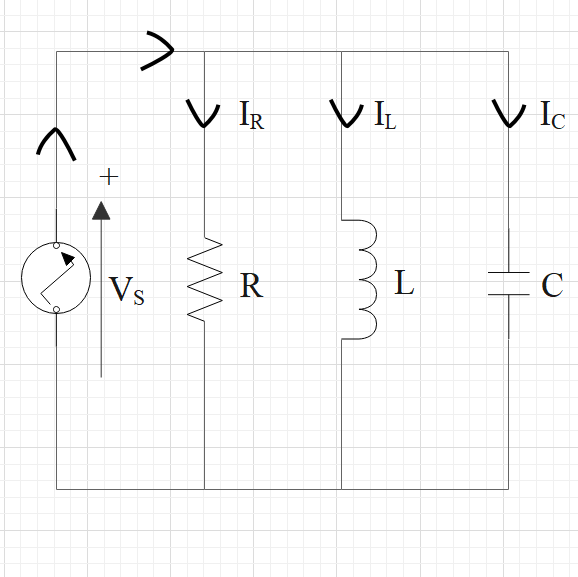
For RLC parallel resonance circuit when $R=8k\Omega, L=80mH$and $C=0.50\mu F$; the Q factor is:
a) 10
b) 20
c) 40
d) 80
Answer
564k+ views
Hint: An RLC circuit is an electrical circuit consisting of a resistor (R), an inductor (L), and a capacitor (C), connected in series or in parallel. The name of the circuit is derived from the letters that are used to denote the constituent components of this circuit, where the sequence of the components may vary from RLC. It is shown below with the help of a diagram:

The selectivity or Q-factor for a parallel resonance circuit is the ratio of the circulating branch currents to the supply current, i.e.
$Q=R\sqrt{\dfrac{C}{L}}$
By using this formula, find the Q-factor for the given RLC parallel circuit.
Complete step by step answer:
As we have:
$\begin{align}
& R=8k\Omega \\
& L=80mH \\
& C=0.50\mu F \\
\end{align}$
So, by using the formula $Q=R\sqrt{\dfrac{C}{L}}$
We get:
$\begin{align}
& Q=8\times {{10}^{3}}\Omega \sqrt{\dfrac{0.50\times {{10}^{-6}}F}{80\times {{10}^{-3}}H}} \\
& =20
\end{align}$
So, we have Q-factor = 20
So, the correct answer is “Option B”.
Note:
The quality factor relates to the maximum or peak energy stored in the circuit (the reactance) to the energy dissipated (the resistance) during each cycle of oscillation. It is a dimensionless parameter. In parallel resonance RLC circuits, since the voltage remains the same across the circuit, so the quality factor gives the current magnification.
Similarly, for a series resonance RLC circuit, the current remains the same, so the quality factor gives the voltage magnification across the circuit.
Hence, we can say that the O- factor of a parallel resonance circuit is the inverse of the expression of the Q-factor of the series circuit.

The selectivity or Q-factor for a parallel resonance circuit is the ratio of the circulating branch currents to the supply current, i.e.
$Q=R\sqrt{\dfrac{C}{L}}$
By using this formula, find the Q-factor for the given RLC parallel circuit.
Complete step by step answer:
As we have:
$\begin{align}
& R=8k\Omega \\
& L=80mH \\
& C=0.50\mu F \\
\end{align}$
So, by using the formula $Q=R\sqrt{\dfrac{C}{L}}$
We get:
$\begin{align}
& Q=8\times {{10}^{3}}\Omega \sqrt{\dfrac{0.50\times {{10}^{-6}}F}{80\times {{10}^{-3}}H}} \\
& =20
\end{align}$
So, we have Q-factor = 20
So, the correct answer is “Option B”.
Note:
The quality factor relates to the maximum or peak energy stored in the circuit (the reactance) to the energy dissipated (the resistance) during each cycle of oscillation. It is a dimensionless parameter. In parallel resonance RLC circuits, since the voltage remains the same across the circuit, so the quality factor gives the current magnification.
Similarly, for a series resonance RLC circuit, the current remains the same, so the quality factor gives the voltage magnification across the circuit.
Hence, we can say that the O- factor of a parallel resonance circuit is the inverse of the expression of the Q-factor of the series circuit.
Recently Updated Pages
Master Class 12 Business Studies: Engaging Questions & Answers for Success

Master Class 12 Economics: Engaging Questions & Answers for Success

Master Class 12 English: Engaging Questions & Answers for Success

Master Class 12 Maths: Engaging Questions & Answers for Success

Master Class 12 Social Science: Engaging Questions & Answers for Success

Master Class 12 Chemistry: Engaging Questions & Answers for Success

Trending doubts
What are the major means of transport Explain each class 12 social science CBSE

Which are the Top 10 Largest Countries of the World?

Draw a labelled sketch of the human eye class 12 physics CBSE

How much time does it take to bleed after eating p class 12 biology CBSE

Explain sex determination in humans with line diag class 12 biology CBSE

Differentiate between homogeneous and heterogeneous class 12 chemistry CBSE




